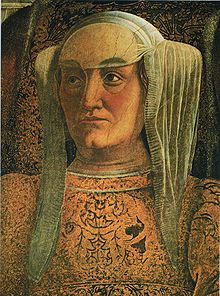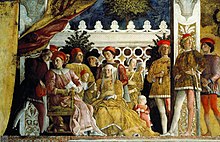Barbara of Brandenburg (1422–1481)


Barbara von Brandenburg (born September 30, 1422 , † November 7, 1481 in Mantua ) was a princess of Brandenburg and by marriage Margravine of Mantua .
Life
Barbara was the eldest child of Margrave Johann von Brandenburg (1406–1464), called the alchemist from his marriage to Barbara (1405–1465), daughter of Duke Rudolf III. of Saxony-Wittenberg . Barbara's father renounced the rights of his firstborn and the succession to the throne in Brandenburg and received the Franconian possessions of the Hohenzollern .
On November 12, 1433, at the age of 11, she married Margrave Ludovico III in Mantua . Gonzaga of Mantua (1412-1478). The marriage with the relatives of the emperor and the Elector of Brandenburg meant a considerable appreciation of the Gonzaga family , who had only recently been elevated to Margrave of Mantua by Emperor Sigismund . Barbara, who grew up at court in Mantua with other members of the Gonzaga family, became one of the most remarkable and cultured women of the Renaissance . She spoke four languages and was well versed in literature. The humanist Vittorino da Feltre was one of her instructors .
Even her husband took part in the government, the highly respected Barbara, who was responsible for government affairs on her own during his frequent absences. She paid particular attention to the relationship between Mantua and the Holy Roman Empire. She married three of her children to German princes and princesses. In the fresco The Court of Gonzaga by the Italian artist Andrea Mantegna , Barbara is also shown as the central figure. Barbara conducted extensive correspondence, some of which was diplomatic, not only with her family, but also with the Visconti , the curia and numerous personalities of the empire.
After the death of her husband, she took over the reign of Mantua for her eldest son. She personally supervised the education and upbringing of her children.
Barbara von Brandenburg is the main character in the historical novel La princesse de Mantoue by the writer Marie Ferranti.
progeny
From their marriage, Barbara had the following eleven children:
- Federico I (1441–1484), Margrave of Mantua ⚭ 1463 Princess Margaret of Bavaria (1442–1479)
- Francesco (1444-1483), cardinal
- Paola (1445-1447)
- Gianfrancesco (1446–1496) Count of Sabbioneta, Lord of Bozzolo ⚭ Princess Antonia del Balzo of Altamura (1461–1538)
- Susanna (1447-1481), nun
- Dorotea (1449–1467), engaged until 1466 to Duke Galeazzo Maria Sforza of Milan (1444–1476)
- Cecilia (1451-1478), nun
-
Rodolfo (1452–1495) Lord of Castiglione and Solferino
- ⚭ 1. 1481 Antonia Malatesta of Rimini († 1483)
- ⚭ 2. 1484 Caterina Pico of Mirandola († 1501)
- Barbara (1455–1503) ⚭ 1474 Duke Eberhard I of Württemberg (1445–1496)
- Ludovico (1458–1511), Bishop of Mantua 1483
- Paola (1463 / 64–1496) ⚭ 1478 Count Leonhard von Görz (1444–1500)
literature
- Jane Couchman, Ann Crabb: Women's letters across Europe. 1400-1700 . Ashgate Publishing, Ltd., 2005, p. 104 ff.
- Ebba Severidt: Family, Kinship And Career With The Gonzaga: Structure And Function Of Family And Kinship With The Gonzaga And Their German Relatives 1444-1519 . DRW, 2002
Web links
- women in leadership: 1478-before 1481 Regent Dowager Margravine Barbara von Hohenzollern of Mantua
- Barbara von Brandenburg-Hohenzollern (1422-1481), wife of Ludovico III. ( Around 1500. Leonhard and Paola - an unequal couple. )
Individual evidence
- ^ Innsbruck historical studies , published by historians from the University of Innsbruck 1997, accessed on June 24, 2018
- ↑ ancestors
- ↑ Guido Rebecchini: Private collectors in Mantua, 1500-1630 , Ed. di Soria e Letteratura, 2002, p. 25
- ↑ Erika Kartschoke, Walter Behrendt: Repertory of German-Language Marriage Teachings of the Early Modern Era , Volume 1, Akademie Verlag, 1996, p. 22
- ^ Schwaebische.de : Novel Prize of the Academie française for Marie Ferranti , October 24, 2002
| personal data | |
|---|---|
| SURNAME | Barbara of Brandenburg |
| BRIEF DESCRIPTION | Margravine of Mantua |
| DATE OF BIRTH | September 30, 1422 |
| DATE OF DEATH | November 7, 1481 |
| Place of death | Mantua |